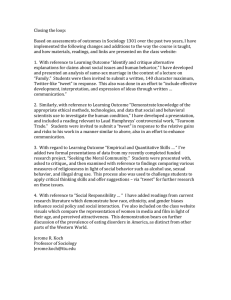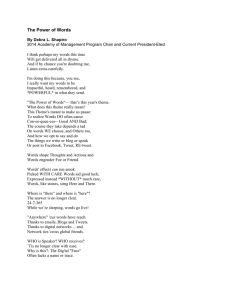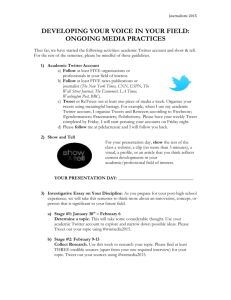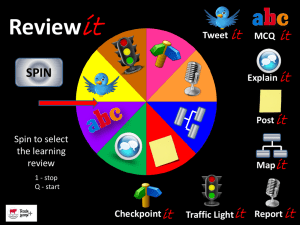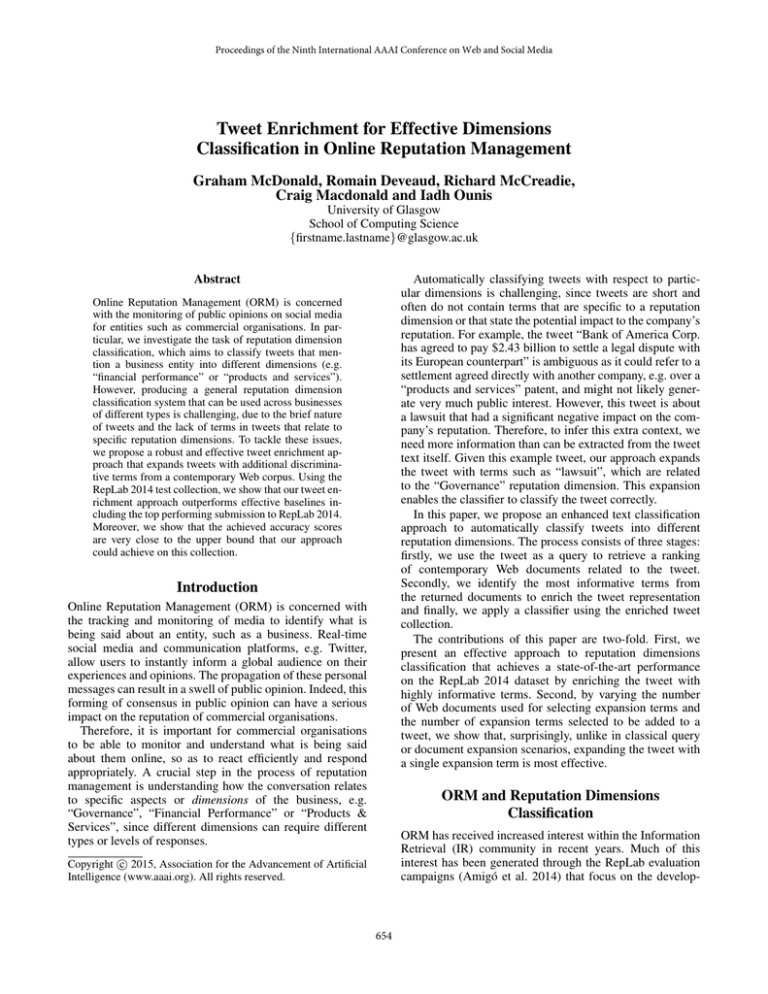
Proceedings of the Ninth International AAAI Conference on Web and Social Media
Tweet Enrichment for Effective Dimensions
Classification in Online Reputation Management
Graham McDonald, Romain Deveaud, Richard McCreadie,
Craig Macdonald and Iadh Ounis
University of Glasgow
School of Computing Science
{firstname.lastname}@glasgow.ac.uk
Abstract
Automatically classifying tweets with respect to particular dimensions is challenging, since tweets are short and
often do not contain terms that are specific to a reputation
dimension or that state the potential impact to the company’s
reputation. For example, the tweet “Bank of America Corp.
has agreed to pay $2.43 billion to settle a legal dispute with
its European counterpart” is ambiguous as it could refer to a
settlement agreed directly with another company, e.g. over a
“products and services” patent, and might not likely generate very much public interest. However, this tweet is about
a lawsuit that had a significant negative impact on the company’s reputation. Therefore, to infer this extra context, we
need more information than can be extracted from the tweet
text itself. Given this example tweet, our approach expands
the tweet with terms such as “lawsuit”, which are related
to the “Governance” reputation dimension. This expansion
enables the classifier to classify the tweet correctly.
In this paper, we propose an enhanced text classification
approach to automatically classify tweets into different
reputation dimensions. The process consists of three stages:
firstly, we use the tweet as a query to retrieve a ranking
of contemporary Web documents related to the tweet.
Secondly, we identify the most informative terms from
the returned documents to enrich the tweet representation
and finally, we apply a classifier using the enriched tweet
collection.
The contributions of this paper are two-fold. First, we
present an effective approach to reputation dimensions
classification that achieves a state-of-the-art performance
on the RepLab 2014 dataset by enriching the tweet with
highly informative terms. Second, by varying the number
of Web documents used for selecting expansion terms and
the number of expansion terms selected to be added to a
tweet, we show that, surprisingly, unlike in classical query
or document expansion scenarios, expanding the tweet with
a single expansion term is most effective.
Online Reputation Management (ORM) is concerned
with the monitoring of public opinions on social media
for entities such as commercial organisations. In particular, we investigate the task of reputation dimension
classification, which aims to classify tweets that mention a business entity into different dimensions (e.g.
“financial performance” or “products and services”).
However, producing a general reputation dimension
classification system that can be used across businesses
of different types is challenging, due to the brief nature
of tweets and the lack of terms in tweets that relate to
specific reputation dimensions. To tackle these issues,
we propose a robust and effective tweet enrichment approach that expands tweets with additional discriminative terms from a contemporary Web corpus. Using the
RepLab 2014 test collection, we show that our tweet enrichment approach outperforms effective baselines including the top performing submission to RepLab 2014.
Moreover, we show that the achieved accuracy scores
are very close to the upper bound that our approach
could achieve on this collection.
Introduction
Online Reputation Management (ORM) is concerned with
the tracking and monitoring of media to identify what is
being said about an entity, such as a business. Real-time
social media and communication platforms, e.g. Twitter,
allow users to instantly inform a global audience on their
experiences and opinions. The propagation of these personal
messages can result in a swell of public opinion. Indeed, this
forming of consensus in public opinion can have a serious
impact on the reputation of commercial organisations.
Therefore, it is important for commercial organisations
to be able to monitor and understand what is being said
about them online, so as to react efficiently and respond
appropriately. A crucial step in the process of reputation
management is understanding how the conversation relates
to specific aspects or dimensions of the business, e.g.
“Governance”, “Financial Performance” or “Products &
Services”, since different dimensions can require different
types or levels of responses.
ORM and Reputation Dimensions
Classification
ORM has received increased interest within the Information
Retrieval (IR) community in recent years. Much of this
interest has been generated through the RepLab evaluation
campaigns (Amigó et al. 2014) that focus on the develop-
c 2015, Association for the Advancement of Artificial
Copyright Intelligence (www.aaai.org). All rights reserved.
654
Products & Services
Innovation
Workplace
Citizenship
Governance
Leadership
Performance
Products and services offered by the company or reflecting the consumers’ satisfaction.
Innovativeness shown by the company, nurturing novel ideas and incorporating them into products.
Employees’ satisfaction or the company’s ability to attract, form and
keep talented and highly qualified people.
Company acknowledgment of community and environmental responsibility, including ethic aspects of the business: integrity, transparency
and accountability.
The relationship between the company and the public authorities.
The leading position of the company.
The company’s long term business success and financial soundness.
Table 1: Reputation Dimension Definitions.
Figure 1: Tweet enrichment and classification process.
ment of reputation management systems for managing the
reputation of companies.
The task of Reputation Dimensions Classification was
first introduced within RepLab 2014 (Amigó et al. 2014)
and aims to classify tweets relating to a business entity into
one of the seven reputation dimensions shown in Table 1.
The task is defined as a multi-class classification task
where, given a tweet about an entity of interest E and a
set of reputation dimensions D = {d1 , d2 , ...}, the goal is
to automatically classify the tweet to the single reputation
dimension that the tweet relates to.
The approach that we present and expand upon here
achieved the best accuracy results in the RepLab 2014
task (McDonald et al. 2014). In particular, we deploy a
query expansion (QE) technique to identify terms that relate
to the reputation dimension of the tweet. It has been shown
in the TREC microblog track (Ounis et al. 2011) that using
QE could enhance tweet retrieval effectiveness. However,
such approaches select query expansion terms from the set
of retrieved tweets in the collection. Differently, we use an
external, contemporaneous Web corpus to obtain expansion
terms for enriching the collection (Kwok and Chan 1998)
before classifying the tweets. While addressing the different
task of identify concepts in tweets, Meije et al. (2012) represents a related work, in that they enrich the representation of
tweets by identifying related articles from Wikipedia based
on word n-grams. On the other hand, we use the expansion
terms obtained from a Web corpus to perform an enhanced
text classification for identifying reputation dimensions.
enrich the tweet. To do so, we first clean the retrieved Web
documents from non-informative content by removing all
HTML (including CSS and JavaScript) markup, stopwords,
and non-word characters. Then, we build a language model
θn from the cleaned and concatenated textual content of the
top n documents, before computing the entropy H(w) of
each term w ∈ θn (step 2):
H(w) = −P (w|θn ) log P (w|θn )
(1)
We chose entropy to score terms since it has been shown
to be effective in identifying highly informative terms
and multi-word terms within documents (Villada Moirn
and Tiedemann 2006). Here, the probability of word w is
computed using a maximum likelihood estimate:
tfw,θn
.
w0 ∈θn tfw0 ,θn
P (w|θn ) = P
(2)
Finally, we select the top k terms, ranked by entropy, and
concatenate them to the tweet text to form the enhanced
tweet representation before converting the enhanced tweet
to a term frequency (tf) vector to train a classifier. Our tweet
enrichment approach is a general solution and any classifier
can be applied to the enriched collection. However, we
found the combination of tf features and an SVM classifier (Chang and Lin 2011) to be the most effective1 and so
due to space constraints we report this configuration.
Experimental Setup
Tweet Enrichment for Dimension
Classification
In this section we first give an overview of the Reputation
Dimensions Classification corpus, before detailing the
baselines and evaluation measures we use. Finally, we give
an overview of our classification setup.
Corpus: The RepLab 2014 Reputation Dimensions
corpus is a collection of tweets, in which each tweet relates
to one of 31 entities from the automotive or banking domains (20 automotive, 11 banking). The collection contains
English and Spanish tweets crawled between 1st June 2012
and 31st December 2012. The ratio of English to Spanish
tweets is approx. 3:1. The task organisers supplied the tweet
ids and corresponding ground truth labels for the seven
reputation dimensions.
There are 15,294 training tweets and 32,447 test tweets.
The number of tweets and the time period the tweets were
In this section we present our proposed approach to Reputation Dimensions Classification. Our approach enhances
text classification by enriching the tweets with externally
sourced expansion terms that are related to the tweet’s
reputation dimension.
As illustrated in Figure 1, our reputation dimension classification approach is a sequence of three main steps: (1) the
retrieval of Web documents that are topically related to the
tweet of interest, (2) the extraction of the most informative
terms from these documents, and (3) the classification of the
tweet after being further enriched with informative terms.
Firstly, we submit the entire tweet as a query to a Web
corpus in order to retrieve a ranked list of documents that
are topically related to this tweet (step 1). We then use the
top n documents to extract a set of terms that will be used to
1
Binary, tf and tf-idf feature representations, and SVM, Naive
Bayes and Random Forests classifiers were tested.
655
Approach
RepLab Baseline
RepLab Average
RepLab Best
SVM No-Enrichment
Enriched-SVM (n = 10, k = 1)
Enriched-SVM (n = 30, k = 1)
Training
Per-Entity
N/A
Across-Entities
Across-Entities
Across-Entities
Oracle
Precision
0.5332
0.4865
0.4928
0.4904
0.75024
0.75224
Recall
0.3293
0.3412
0.4697
0.1568
0.38614
0.38624
F1
0.4072
0.3942
0.4810
0.2361
0.50164
0.50224
Accuracy
0.6222
0.6425
0.7319
0.4854
0.74314
0.74514
Table 2: Reputation dimension classification performance of each baseline and our proposed approach. The best performance
is highlighted in bold. Statistical significant improvements (averaged across the entities) over the SVM Baseline (two-sided
pairwise t-test p < 0.01) are denoted 4 .
training split of the collection (n = 10,k = 1).
collected varies between entities in the training and test
splits of the corpus. For each entity, at least 700 tweets from
the start of the crawl period were selected as training tweets,
leaving at least 1,500 test tweets for each entity.
Baselines: We compare our approach with two different baselines from RepLab 2014. The first one, RepLab
Baseline, is composed of 31 different SVM classifiers, each
trained on tweets relating to a single entity (Amigó et al.
2014). The second baseline, RepLab Average, is the average
of all the systems that were submitted to RepLab 2014.
Evaluation measures: In our experiments, we report
Precision, Recall, F1 , and Accuracy. Precision, Recall and
F1 are calculated by macro averaging across reputation
dimensions and micro averaging across entities.
Classification: As shown in step 1 of Figure 1, to
retrieve the set of top n documents, we use the Terrier
IR platform (Ounis et al. 2006) with the BM25 retrieval
model, using the default Terrier settings. Documents are
retrieved from an index of ClueWeb12B2 , a collection of
52 million Web pages that were crawled in the first half of
2012. No stemming or stopword removal was applied to the
ClueWeb12 corpus or the tweet queries.
Next, having retrieved the top n documents, we select the
top k terms ranked by entropy as enrichment terms and add
the terms to the tweet to construct the enriched tweet, as
shown in step 2 of Figure 1.
After adding the enrichment terms to the tweet, we remove English stopwords and convert @ people mentions
and # hashtags to simple terms by removing the nonalphanumeric characters. The enriched tweet is then converted to tf feature vectors for input to the classification stage
of our approach, shown in step 3 of Figure 1.
To perform the text classification, we use the WEKA (Hall
et al. 2009) machine learning platform with the LIBSVM (Chang and Lin 2011) extension and a linear kernel.
As the task is a multi-class classification task where we
want to classify a tweet into one of the seven reputation
dimensions, we perform a 1-against-1 classification using
pairwise coupling. Moreover, we are interested in developing a general Reputation Dimensions Classification
solution that is not dependent on prior knowledge of the
entity. Therefore, different to the RepLab 2014 baseline
detailed above, we train a single global model for all 31
business entities. Finally, we learn the effective values of n
documents and k terms by optimising for Accuracy on the
2
Reputation Dimensions Classification Results
In this section, we report and analyse the results of our proposed tweet enrichment approach. We seek to answer two research questions. Firstly, “Is our tweet enrichment approach
more effective for classifying tweets to reputation dimensions than a non-enriched approach?” and, secondly, “Which
setting of n documents and k terms achieves the best reputation dimensions classification Accuracy?”.
Table 2 shows the results of our tweet enrichment approach, denoted as Enriched-SVM (n = 10, k = 1), and the
baselines RepLab Baseline and RepLab Average. Table 2
also shows the results this approach achieved in RepLab
2014 (McDonald et al. 2014), denoted as RepLab Best, and
the results achieved by text classification when the tweet
enrichment approach is not applied (i.e. setting the n and k
parameter values to 0), denoted as SVM No-Enrichment. Finally, in order to assess the best achievable performance that
our approach could attain, we also report an oracle where
the values of n and k maximise the Accuracy on the test set.
On analysing Table 2, we first see that our tweet enrichment approach achieves the best performance in terms of
Precision, F1 measure, and Accuracy when compared to
the baselines. Moreover, it shows substantial and significant
improvements over the SVM classification when tweet
enrichment is not applied. The deployed configuration of
n = 10 documents and k = 1 terms also outperforms
RepLab Best by greatly improving Precision (+52.2%)
while slightly degrading Recall (-17.8%).
Finally, we see that Enriched-SVM (n = 10, k = 1)
achieves performances that are very close to the upperbound Accuracy that our tweet enrichment approach could
possibly achieve on the RepLab 2014 dataset, i.e. when we
set n = 30 documents and k = 1 terms.
In answer to our first research question, we conclude
that enriching tweets with terms extracted from a Web
corpus achieves a significant improvement in classification
results over a non-enriched approach, while achieving
state-of-the-art results on the RepLab 2014 dataset.
Next, using Table 3 we examine the influence of the
number of documents n and the number of enrichment
terms k over the Accuracy of our approach.
Firstly, on analysing Table 3, we note that our approach
outperforms the 0.7319 Accuracy achieved by RepLab Best
for each value of n when k is set to 1. Secondly, we observe
http://www.lemurproject.org/clueweb12.php
656
n, # of documents
k, # of enrichment terms
1
5
10
20
30
40
50
75
100
1
5
10
20
30
40
50
0.7440
0.7361
0.7316
0.7254
0.7191
0.7161
0.7131
0.7033
0.6983
0.7443
0.7411
0.7396
0.7335
0.7310
0.7292
0.7298
0.7251
0.7223
0.7431
0.7395
0.7363
0.7319
0.7327
0.7319
0.7268
0.7313
0.7305
0.7427
0.7352
0.7332
0.7390
0.7332
0.7334
0.7269
0.7322
0.7310
0.7451
0.7361
0.7390
0.7377
0.7330
0.7323
0.7340
0.7281
0.7302
0.7437
0.7380
0.7354
0.7374
0.7347
0.7353
0.7298
0.7300
0.7275
0.7435
0.7414
0.7389
0.7365
0.7335
0.7334
0.7315
0.7310
0.7286
Table 3: Accuracy scores for our tweet enrichment approach as we vary the values of the n and k parameters. The deployed
configuration, n = 10 k = 1, is highlighted in bold.
References
that our approach yields similar performances when using
any number of documents from 5 to 50, although Accuracy
tends to decrease when enriching the tweets with a large
number of terms. This demonstrates the robustness of our
tweet enrichment approach.
Thirdly, and surprisingly, we see that for each n (number
of documents) retrieved, our approach achieves its best
Accuracy when performing a single-term enrichment
(i.e. k is set to 1). This differs from similar experiments
in microblog retrieval where using 10 to 20 enrichment
terms has been shown to be effective (Li et al. 2011;
Amati et al. 2011). Moreover, in ad-hoc document retrieval,
it has been shown that expanding a query with 10 to 40 terms
tends to achieve the best performance (Cui et al. 2002).
Indeed, although the performance slightly decreases
when more terms are added to the tweet, Accuracy stays
well above the non-enriched SVM classification (0.4854
Accuracy), showing again the effectiveness of our approach
for this task.
In answer to our second research question, we conclude
that using one single enrichment term always allows to
achieve the best results, while we can use any number of
documents, between 5 and 50, without markedly altering the
Accuracy. An initial inspection of the single terms selected
as expansion terms suggests that our tweet enrichment approach selects terms that are specific to a reputation dimension for the entity in the tweet. Future work will investigate
further what makes a good expansion term for this task.
Amati, G.; Amodeo, G.; Bianchi, M.; Marcone, G.; Bordoni,
F. U.; Gaibisso, C.; Gambosi, G.; Celi, A.; Di Nicola, C.; and
Flammini, M. FUB, IASI-CNR, Univaq at TREC 2011 Microblog track. In Proc. of TREC’11.
Amigó, E.; Carrillo-de-Albornoz, J.; Chugur, I.; Corujo, A.;
Gonzalo, J.; Meij, E.; de Rijke, M.; and Spina, D. Overview
of RepLab 2014: Author profiling and reputation dimensions
for Online Reputation Management. In Proc. of CLEF’14.
Chang, C.-C., and Lin, C.-J. LIBSVM: A Library for Support
Vector Machines. ACM Trans. Intell. Syst. Technol. 2(3):27:1–
27:27, 2011.
Cui, H.; Wen, J.-R.; Nie, J.-Y.; and Ma, W.-Y. Probabilistic
Query Expansion Using Query Logs. In Proc. of WWW’02.
Hall, M.; Frank, E.; Holmes, G.; Pfahringer, B.; Reutemann, P.;
and Witten, I. H. The WEKA data mining software: an update.
ACM SIGKDD explorations newsletter 11(1):10–18, 2009.
Kwok, K. L., and Chan, M. Improving two-stage ad-hoc retrieval for short queries. In Proc. of SIGIR’98.
Li, Y.; Zhang, Z.; Lv, W.; Xie, Q.; Lin, Y.; Xu, R.; Xu, W.; Chen,
G.; and Guo, J. PRIS at TREC 2011 Microblog track. In Proc.
of TREC’11.
McDonald, G.; Deveaud, R.; McCreadie, R.; Gollins, T.; Macdonald, C.; and Ounis, I. University of Glasgow Terrier Team /
Project Abac at RepLab 2014: Reputation Dimensions Task. In
Proc. of CLEF’14.
Meij, E.; Weerkamp, W.; and de Rijke, M. 2012. Adding semantics to microblog posts. In Proc. of WSDM’12.
Ounis, I.; Amati, G.; Plachouras, V.; He, B.; Macdonald, C.;
and Lioma, C. Terrier: A High Performance and Scalable Information Retrieval Platform. In Proc. of OSIR’06.
Ounis, I.; Macdonald, C.; Lin, J.; and Soboroff, I. Overview of
the TREC-2011 Microblog track. In Proc. of TREC’11.
Shen, D.; Pan, R.; Sun, J.-T.; Pan, J. J.; Wu, K.; Yin, J.; and
Yang, Q. Query enrichment for web-query classification. ACM
Trans. on Information Systems 24(3):320–352, 2006.
Villada Moirn, B., and Tiedemann, J. Identifying idiomatic
expressions using automatic word alignment. In Proc. of
EACL’06.
Conclusions
In this paper, we have shown that enriching a tweet with
terms from a contemporary external Web corpus helps to
classify the tweet by the reputation dimension that the tweet
relates to. However, surprisingly, we found that using a
single expansion term achieves the best performance on the
RepLab 2014 test collection. Moreover, we showed that our
tweet enrichment approach to reputation dimensions classification achieves an Accuracy score that is very close to the
upper-bound that we could achieve on this collection. As
future work, we intend to conduct a thorough investigation
into how our tweet enrichment approach performs for each
entity and on each reputation dimension.
657




